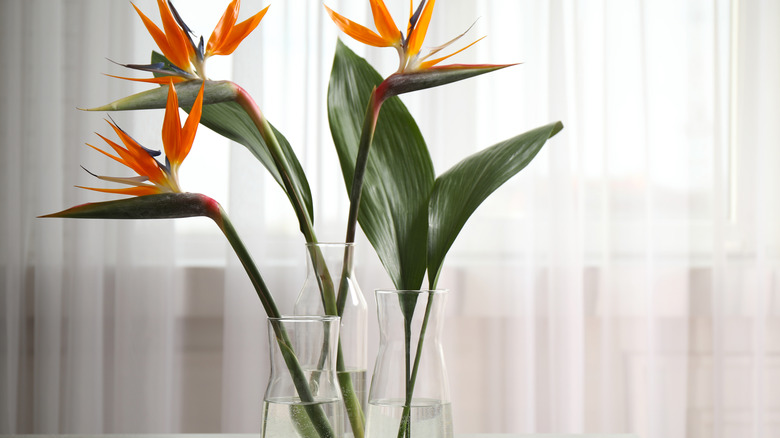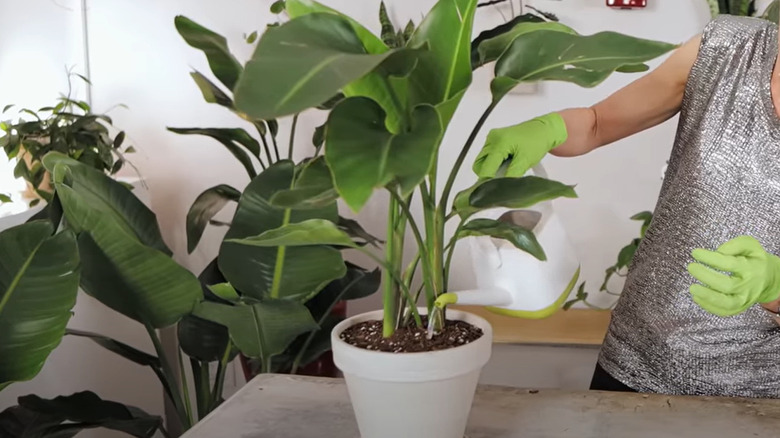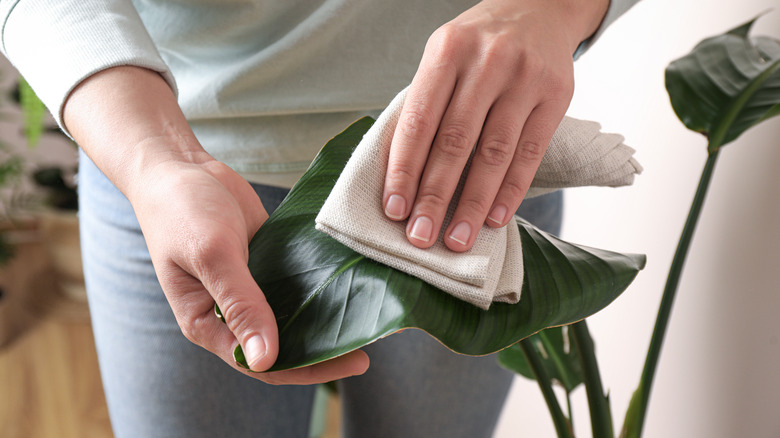Is A Bird Of Paradise A Good Plant For Indoors?
Few flowers mimic an avian mid-flight or a bird head popping out of leaves and get to keep it as their moniker: bird of paradise plants (Strelitzia spp.) are that exception. Native to southern African coasts, you'd reckon these tropical beauties are unlikely to thrive beyond the LA roadside; forget lasting in colder regions — and you'd be wrong! Mostly hardy to USDA zones 10 to 11 when grown outdoors, these ornamentals adjust surprisingly well inside your home, making them great for adding an exotic spin to your décor during the dead winter. Place them in a sunny spot and watch them grow inside the comfort of your home.
Alternatively, going by "crane flower," these shockingly un-fussy tropical plants showcase flashy orange and blue (sometimes white) inflorescence that outshines their equally iridescent grayish-green foliage, occasionally marked with a red midrib. Another fun fact: they grow to 6 feet over five to six years. The downside? Their seeds and fruits are slightly poisonous, causing nausea and puking in children and pets if ingested.
Bird of paradise is easy to care for
The crane flowers have a lot going for them. Even when they aren't blooming midnight blues and sunset hues, they display magnificent, 3- to 4-foot long, waxy evergreen leaves that grow 18 to 24 inches wide. Their show-stopping silverish-green, paddle-shaped, glossy foliage is enough to brighten up any indoor space, including swimming pools, without unwanted leaf litter! And we haven't even gotten to the best part: they're low-maintenance.
Unlike their tropical brethren, bird of paradise plants couldn't care less about the soil. They'll be content if it drains well and doesn't leave the roots soggy over extended periods — although loamy soils are much appreciated, as is the addition of pine bark or coco coir. These origami-esque flower owners are moderately drought-tolerant and prefer weekly watering except during the dormant winter when they would rather the potting mix be dry for a while. A diluted all-purpose fertilizer is all you need to grow these plants during spring and summer. And too, these imposing specimens live over 50 years without losing their green sheen even once.
Some best practices to follow
Long lives, however, don't translate to a longer flowering duration. A bird of paradise blooming isn't a surety if you've been slacking off in the lighting department. They need around eight hours of sunlight to bloom — unless it's summer when higher temperatures could cause leaf scalding. Usually, west- and south-facing windows serve as the best spots. But if the sun exposure is limited, shine an artificial grow light on the flashy plants. Further, ensure the indoor winter temperatures don't exceed 60 degrees Fahrenheit.
Another factor to keep in mind is how you pot the herbaceous perennial. It shouldn't be planted too deep, meaning the top roots should remain exposed, and its spreading shouldn't spur you into repotting it. Though it feels neglectful, the best blooms are achieved when the container becomes crowded, and the topsoil is replaced yearly. However, if crane flowers still fail to blossom and you notice browning leaves, check the water for its mineral and salt content.
If high, irrigate the plant with purified or rainwater. Also, consider using a dehumidifier, pebble tray, or occasional misting to maintain 60% humidity during the cool season. Remember, indoor-grown strelitzias are more susceptible to pests like spider mites and mealybugs, so dust off the plant regularly and treat it with neem oil or insecticides if need be. Finally, if you don't have the space for a long tree, opt for shorter Strelitzia cultivars like reginae dwarf or juncea.


